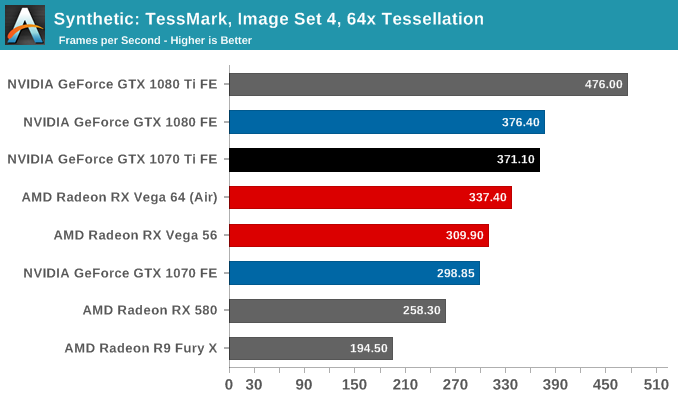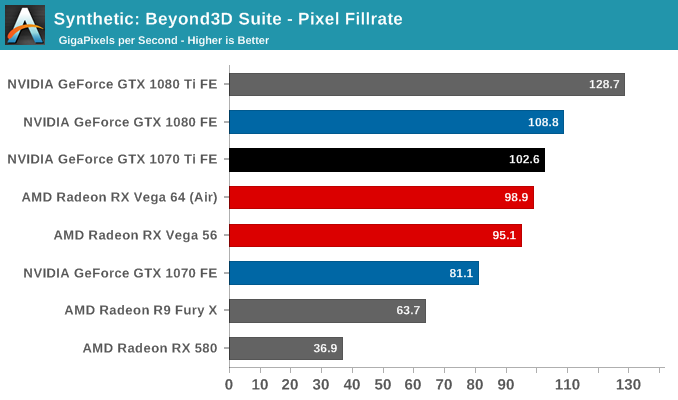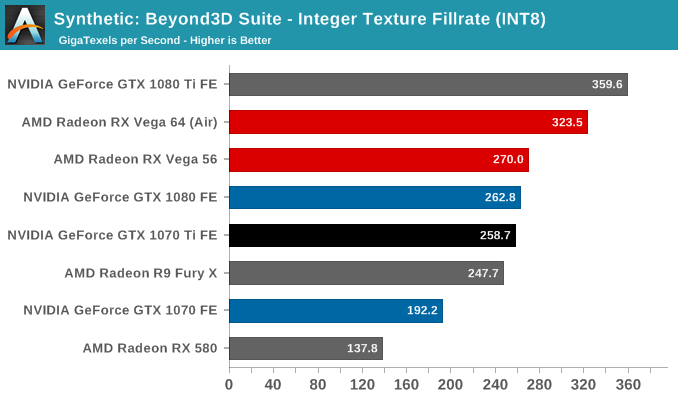The NVIDIA GeForce GTX 1070 Ti Founders Edition Review: GP104 Comes in Threes
by Nate Oh on November 2, 2017 9:00 AM EST- Posted in
- GPUs
- GeForce
- NVIDIA
- Pascal
- GTX 1070 Ti
Synthetics
Continuing onto our synthetic benchmarks, we should be able to see how the GTX 1070 Ti sits in between the GTX 1080 and 1070. These tests are more graphics focused than compute focused – especially the low-level tests – so it will be interesting to see how the GTX 1070 Ti compares to its fully-featured GP104 sibling, the GTX 1080, given how close they are so often in compute tests.

Starting off with tessellation performance, as NVIDIA's geometry performance is tied to the SMs, the GTX 1070 Ti benefits from having 3 more SMs enabled than the vanilla GTX 1070. This allows the new card to leapfrog both AMD Vega cards, coming in right behind the GTX 1080.

Switching gears, we have Futuremark's VRMark Orange benchmark. Essentially a synthetic gaming-type rendering workload with a focus on VR, this test pushes every part of a video card. Consequently, it also hits the weaker parts of the GTX 1070 Ti's configuration, particularly the lack of increased ROP throughput and memory bandwidth. As a result the GTX 1070 Ti still gains quite a bit over the GTX 1070, but it also trails the GTX 1080 by about 5%. Which, as it turns out, isn't too far removed from our general gaming benchmarks.
Finally, for looking at texel and pixel fillrate, we have the Beyond3D Test Suite. This test offers a slew of additional tests – many of which use behind the scenes or in our earlier architectural analysis – but for now we’ll stick to simple pixel and texel fillrates.

The pixel fillrate test is actually one of the more interesting results we have in today's review. While the GTX 1070 Ti doesn't get any more ROP resources on paper, pixel fillrates are a combination of both ROP (backend) and rasterizer (frontend) output. And in the case of NVIDIA's architecture, rasterization is not fully decoupled from the SMs; which is to say there's some scaling going on. And actually, this was more than I was expecting, with the GTX 1070 Ti coming very close to the GTX 1080 despite the memory bandwidth disadvantage. Not unlike tessellation performance, we see the new card leapfrog both AMD Vega cards here, pushing over 100 Gigapixels per second. In general pixel throughput is still going to be what best differentiates the GTX 1080 from the GTX 1070 Ti, but in this low-level test the two are closer than I would have expected.


Finally, for texture throughput, we're once again looking at a scenario tightly-coupled with the SM count. As a result the GTX 1070 Ti can deliver texture throughput rates very close to the GTX 1080.










78 Comments
View All Comments
CiccioB - Thursday, November 2, 2017 - link
Price is dictated by the basic market supply/demand rule.Being a so basic rule, I can't understand why people continuously whine about too high prices.
Do you think you are better than the entire nvidia marketing team?
Do you think that lowering the prive as you suggest is going to make nvidia gain more money?
kmmatney - Thursday, November 2, 2017 - link
Why should our goal be to make NVidia more money?nyquaxyla - Thursday, November 2, 2017 - link
Why should Nvidia's goal be to make any less money than the most that they can make?I'm not saying that I like this system.. I too wish there was more competition from AMD, and GPU prices were lower.. but the harsh reality is that profits are the ultimate decider, and every business will try to maximize the same.. it doesn't make them bad or evil people.
darckhart - Thursday, November 2, 2017 - link
Come on, this card shouldn't even exist. Only because miners have created supply shortages has NV decided to put another something out there. It's purely a cash grab. 1 less SM than a 1080? No factory overclocks because it could cannibalize 1080 sales? The only people looking for new 1080s are probably miners once again. And compete against Vega56? Come on. No one can GET a Vega56 at MSRP.CiccioB - Friday, November 3, 2017 - link
You are getting it wrong.People here whine about how the things should work and indeed they work that way.
Companies exists to make money (rule number one companies based on capitals) and whining because they try to make more of them is quite useless like whining about the fact that if you leave your smartphone it will fall down.
So constantly speaking about wrong or right prices from OUR point of view is useless and quite stupid. I can't see people whining about the fact that the gravity is too high and that falling smartphones can't be grabbed before they touch the ground.
They are basic rules that makes things work (one the economics, the other one the universe) so it is really useless to point about wrong prices. People have learnt that whining about gravity won't change the effects, but it appears that they have still not understood that good prices is a simple supply/demand affair.
We all would like a GTX1080/Vega to cost $50 and that smartphones would not fall so fast, but that is our vain wish, not what can be either possible or even clever to discuss on a technical forum like this one. More if you do not understand economics.
kmmatney - Friday, November 3, 2017 - link
These cards are marketed to gamers. However the "demand" (what is driving up the price) is not from gamers, it's from miners. So the high prices are artificial - if miners weren't snapping up all the cards, they would be lower. Heck, the cards can't even get down to MSRP - we can at least complain about that. At least I bought my 1060 at MSRP, and it is still good enough for now.babadivad - Thursday, November 2, 2017 - link
I still think the Vega 56 is the best value card out there. Granted you can find one.Samus - Thursday, November 2, 2017 - link
I was at Microcenter a month ago when the Vega56 was just becoming available at retail, and this guy was talking to the sales clerk about how it's his fifth one for mining and I just wanted to punch him. He'd apparently been coming back to the store repeatedly to buy them all.That's why I can't find any fucking video cards to upgrade my GTX970/980. And considering it still plays everything (albeit at medium detail in some stuff) I'm just going to ride this GPU gravy train out.
tipoo - Thursday, November 2, 2017 - link
Just when they reach a point of convergent evolution with Intel designs, they seem to slip away on GPUs. Maybe AMD just can't sustain three tentpolls (counting APUs) at once? Spin-out?
Nvidia is spending 3 billion on each new architecture (and in that cost, spliting compute architectures from gaming architectures), while AMD I don't think is even hitting the big B on new architectures, and keeping one for both sides. Too bad, but no wonder results are like this.
Anyways, per the 1070TI, I don't suppose the MRSP will be anywhere near realistic for a while as eth miners are still snapping up any good cards.
Manch - Thursday, November 2, 2017 - link
AMD doesn't have a 1080TI fighter, cant compete on efficiency, and the cards came too little too late. It wasn't enough to match year old cards, they needed to beat them. Miners are their only saving grace right now.That being said, there were some design choices made with integration in mind ala RR, and I think it will pay off in the long run but it wont move cards into gamers hands right now.
Asf or the 1070TI, I don't see the point but I get why NVidia is doing it. Adds an option, crowds out the 56, gives them something to do with those other chips.
IF they actually sell at what they're supposed to sell at, I don't see why you wouldn't spring for the 1080. Price/Perf diff isn't worth the savings when spending that much.